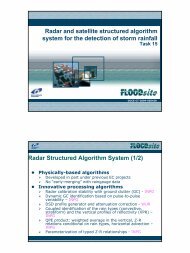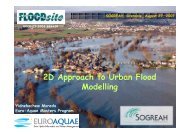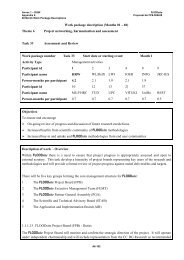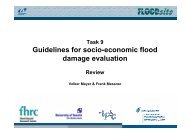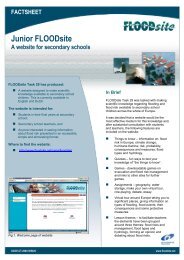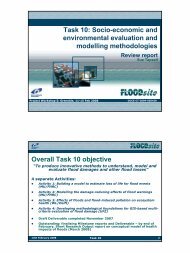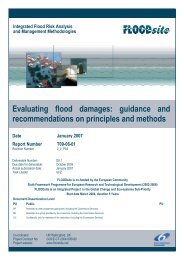Evacuation and traffic management (full report) - FLOODsite
Evacuation and traffic management (full report) - FLOODsite
Evacuation and traffic management (full report) - FLOODsite
You also want an ePaper? Increase the reach of your titles
YUMPU automatically turns print PDFs into web optimized ePapers that Google loves.
Task 17 <strong>Evacuation</strong> D17-1<br />
Contract No:GOCE-CT-2004-505420<br />
2.2.4 Emergency response<br />
‘Response’ encompasses the actions taken to deal with the immediate effects of an emergency. In<br />
many flood scenarios, it is likely to be relatively short <strong>and</strong> to last for a matter of hours or days, so<br />
rapid implementation of arrangements for collaboration, co-ordination <strong>and</strong> communication are,<br />
therefore, vital. Response encompasses the effort to deal not only with the direct effects of the flood<br />
itself (e.g. rescuing individuals, protecting property etc) but also the indirect effects (e.g. disruption,<br />
media interest etc).<br />
Effective response procedures should be flexible <strong>and</strong> tailored but follow a common set of<br />
underpinning principles:<br />
• Continuity (of working, but at a faster pace <strong>and</strong> in more testing circumstances);<br />
• Preparedness (clarity of roles <strong>and</strong> responsibilities);<br />
• Subsidiarity (decisions taken at lowest appropriate level, with co-ordination at highest necessary<br />
level);<br />
• Direction (clarity of strategic aim <strong>and</strong> objectives, enabling prioritisation <strong>and</strong> focus of the response<br />
<strong>and</strong> recovery effort);<br />
• Integration (effective co-ordination to produce integrated effort);<br />
• Co-operation (positive engagement <strong>and</strong> information sharing);<br />
• Communication;<br />
• Anticipation (ongoing risk identification <strong>and</strong> analysis).<br />
Flood response refers to the operations that may be initiated to reduce the hazard of an actual flood<br />
after a flood warning has been issued. These include road control, building up of defences,<br />
evacuation, rescue <strong>and</strong> providing information <strong>and</strong> advice to communities affected by flooding.<br />
Road control may be undertaken by the police or local road authority, depending on local agreements.<br />
It involves closing roads which are liable to flood, planning <strong>and</strong> implementing detours, signposting,<br />
<strong>and</strong> be used to warn road users of flooding.<br />
The Environment Agency <strong>and</strong> local authorities may build up defences using s<strong>and</strong> bags or other means,<br />
although s<strong>and</strong> bags have a number of disadvantages <strong>and</strong> are not used by some local authorities. Local<br />
authorities also provide labour, equipment <strong>and</strong> facilities for conducting a range of response tasks,<br />
including for example lifting or moving furniture for the elderly <strong>and</strong> disabled. Local authorities also<br />
provide temporary accommodation <strong>and</strong> food for evacuees.<br />
Flood wardens are members of the community, who will always be available during the time of a<br />
flood. It should be noted that many floodplain residents will be preoccupied <strong>and</strong> therefore unable to<br />
undertake flood warden duties. Each flood warden is allocated a group of properties, <strong>and</strong> they are<br />
responsible for making sure everyone is aware of the flood. In addition, wardens may facilitate the<br />
evacuation of individuals, particularly families with children, the elderly <strong>and</strong> other vulnerable groups.<br />
Flood wardens must be identifiable <strong>and</strong> known to the local community.<br />
(Environment Agency, 2005a, 2005b)<br />
2.2.5 Management <strong>and</strong> co-ordination of local operations<br />
The objectives for a combined response to a flooding emergency are as follows:<br />
• Saving <strong>and</strong> protecting life;<br />
• Relieving suffering;<br />
• Containing the emergency;<br />
• Providing the public with warnings, advice <strong>and</strong> information;<br />
• Safeguarding the environment;<br />
T17_07_02_<strong>Evacuation</strong>_<strong>and</strong>_<strong>traffic</strong>_<strong>management</strong>_D17_1_V4_4_P01.doc 19 03 2008<br />
14




